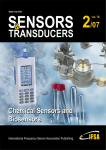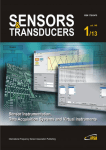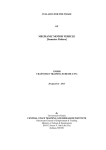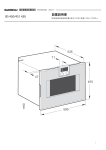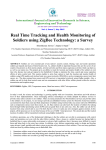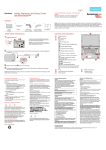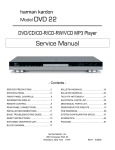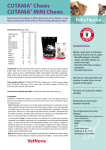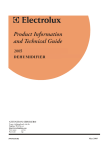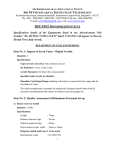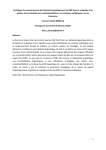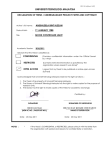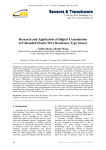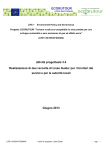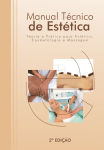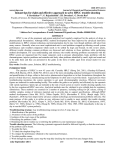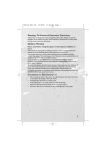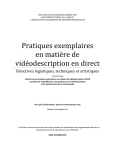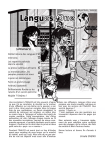Download An Embedded Web based Real Time Application for Remote
Transcript
Sensors & Transducers Volume 136, Issue 1 January 2012 www.sensorsportal.com ISSN 1726-5479 Editors-in-Chief: Sergey Y. Yurish, tel.: +34 93 413 7941, e-mail: [email protected] Editors for Western Europe Meijer, Gerard C.M., Delft University of Technology, The Netherlands Ferrari, Vittorio, Universitá di Brescia, Italy Editor for Eastern Europe Sachenko, Anatoly, Ternopil State Economic University, Ukraine Editor South America Costa-Felix, Rodrigo, Inmetro, Brazil Editor for Africa Maki K.Habib, American University in Cairo, Egypt Editor for Asia Ohyama, Shinji, Tokyo Institute of Technology, Japan Editors for North America Datskos, Panos G., Oak Ridge National Laboratory, USA Fabien, J. Josse, Marquette University, USA Katz, Evgeny, Clarkson University, USA Editor for Asia-Pacific Mukhopadhyay, Subhas, Massey University, New Zealand Editorial Advisory Board Abdul Rahim, Ruzairi, Universiti Teknologi, Malaysia Ahmad, Mohd Noor, Nothern University of Engineering, Malaysia Annamalai, Karthigeyan, National Institute of Advanced Industrial Science and Technology, Japan Arcega, Francisco, University of Zaragoza, Spain Arguel, Philippe, CNRS, France Ahn, Jae-Pyoung, Korea Institute of Science and Technology, Korea Arndt, Michael, Robert Bosch GmbH, Germany Ascoli, Giorgio, George Mason University, USA Atalay, Selcuk, Inonu University, Turkey Atghiaee, Ahmad, University of Tehran, Iran Augutis, Vygantas, Kaunas University of Technology, Lithuania Avachit, Patil Lalchand, North Maharashtra University, India Ayesh, Aladdin, De Montfort University, UK Azamimi, Azian binti Abdullah, Universiti Malaysia Perlis, Malaysia Bahreyni, Behraad, University of Manitoba, Canada Baliga, Shankar, B., General Monitors Transnational, USA Baoxian, Ye, Zhengzhou University, China Barford, Lee, Agilent Laboratories, USA Barlingay, Ravindra, RF Arrays Systems, India Basu, Sukumar, Jadavpur University, India Beck, Stephen, University of Sheffield, UK Ben Bouzid, Sihem, Institut National de Recherche Scientifique, Tunisia Benachaiba, Chellali, Universitaire de Bechar, Algeria Binnie, T. David, Napier University, UK Bischoff, Gerlinde, Inst. Analytical Chemistry, Germany Bodas, Dhananjay, IMTEK, Germany Borges Carval, Nuno, Universidade de Aveiro, Portugal Bousbia-Salah, Mounir, University of Annaba, Algeria Bouvet, Marcel, CNRS – UPMC, France Brudzewski, Kazimierz, Warsaw University of Technology, Poland Cai, Chenxin, Nanjing Normal University, China Cai, Qingyun, Hunan University, China Campanella, Luigi, University La Sapienza, Italy Carvalho, Vitor, Minho University, Portugal Cecelja, Franjo, Brunel University, London, UK Cerda Belmonte, Judith, Imperial College London, UK Chakrabarty, Chandan Kumar, Universiti Tenaga Nasional, Malaysia Chakravorty, Dipankar, Association for the Cultivation of Science, India Changhai, Ru, Harbin Engineering University, China Chaudhari, Gajanan, Shri Shivaji Science College, India Chavali, Murthy, N.I. Center for Higher Education, (N.I. University), India Chen, Jiming, Zhejiang University, China Chen, Rongshun, National Tsing Hua University, Taiwan Cheng, Kuo-Sheng, National Cheng Kung University, Taiwan Chiang, Jeffrey (Cheng-Ta), Industrial Technol. Research Institute, Taiwan Chiriac, Horia, National Institute of Research and Development, Romania Chowdhuri, Arijit, University of Delhi, India Chung, Wen-Yaw, Chung Yuan Christian University, Taiwan Corres, Jesus, Universidad Publica de Navarra, Spain Cortes, Camilo A., Universidad Nacional de Colombia, Colombia Courtois, Christian, Universite de Valenciennes, France Cusano, Andrea, University of Sannio, Italy D'Amico, Arnaldo, Università di Tor Vergata, Italy De Stefano, Luca, Institute for Microelectronics and Microsystem, Italy Deshmukh, Kiran, Shri Shivaji Mahavidyalaya, Barshi, India Dickert, Franz L., Vienna University, Austria Dieguez, Angel, University of Barcelona, Spain Dighavkar, C. G., M.G. Vidyamandir’s L. V.H. College, India Dimitropoulos, Panos, University of Thessaly, Greece Ko, Sang Choon, Electronics. and Telecom. Research Inst., Korea South Kotulska, Malgorzata, Wroclaw University of Technology, Poland Ding, Jianning, Jiangsu Polytechnic University, China Djordjevich, Alexandar, City University of Hong Kong, Hong Kong Donato, Nicola, University of Messina, Italy Donato, Patricio, Universidad de Mar del Plata, Argentina Dong, Feng, Tianjin University, China Drljaca, Predrag, Instersema Sensoric SA, Switzerland Dubey, Venketesh, Bournemouth University, UK Enderle, Stefan, Univ.of Ulm and KTB Mechatronics GmbH, Germany Erdem, Gursan K. Arzum, Ege University, Turkey Erkmen, Aydan M., Middle East Technical University, Turkey Estelle, Patrice, Insa Rennes, France Estrada, Horacio, University of North Carolina, USA Faiz, Adil, INSA Lyon, France Fericean, Sorin, Balluff GmbH, Germany Fernandes, Joana M., University of Porto, Portugal Francioso, Luca, CNR-IMM Institute for Microelectronics and Microsystems, Italy Francis, Laurent, University Catholique de Louvain, Belgium Fu, Weiling, South-Western Hospital, Chongqing, China Gaura, Elena, Coventry University, UK Geng, Yanfeng, China University of Petroleum, China Gole, James, Georgia Institute of Technology, USA Gong, Hao, National University of Singapore, Singapore Gonzalez de la Rosa, Juan Jose, University of Cadiz, Spain Granel, Annette, Goteborg University, Sweden Graff, Mason, The University of Texas at Arlington, USA Guan, Shan, Eastman Kodak, USA Guillet, Bruno, University of Caen, France Guo, Zhen, New Jersey Institute of Technology, USA Gupta, Narendra Kumar, Napier University, UK Hadjiloucas, Sillas, The University of Reading, UK Haider, Mohammad R., Sonoma State University, USA Hashsham, Syed, Michigan State University, USA Hasni, Abdelhafid, Bechar University, Algeria Hernandez, Alvaro, University of Alcala, Spain Hernandez, Wilmar, Universidad Politecnica de Madrid, Spain Homentcovschi, Dorel, SUNY Binghamton, USA Horstman, Tom, U.S. Automation Group, LLC, USA Hsiai, Tzung (John), University of Southern California, USA Huang, Jeng-Sheng, Chung Yuan Christian University, Taiwan Huang, Star, National Tsing Hua University, Taiwan Huang, Wei, PSG Design Center, USA Hui, David, University of New Orleans, USA Jaffrezic-Renault, Nicole, Ecole Centrale de Lyon, France Jaime Calvo-Galleg, Jaime, Universidad de Salamanca, Spain James, Daniel, Griffith University, Australia Janting, Jakob, DELTA Danish Electronics, Denmark Jiang, Liudi, University of Southampton, UK Jiang, Wei, University of Virginia, USA Jiao, Zheng, Shanghai University, China John, Joachim, IMEC, Belgium Kalach, Andrew, Voronezh Institute of Ministry of Interior, Russia Kang, Moonho, Sunmoon University, Korea South Kaniusas, Eugenijus, Vienna University of Technology, Austria Katake, Anup, Texas A&M University, USA Kausel, Wilfried, University of Music, Vienna, Austria Kavasoglu, Nese, Mugla University, Turkey Ke, Cathy, Tyndall National Institute, Ireland Khelfaoui, Rachid, Université de Bechar, Algeria Khan, Asif, Aligarh Muslim University, Aligarh, India Kim, Min Young, Kyungpook National University, Korea South Sandacci, Serghei, Sensor Technology Ltd., UK Saxena, Vibha, Bhbha Atomic Research Centre, Mumbai, India Kockar, Hakan, Balikesir University, Turkey Kong, Ing, RMIT University, Australia Kratz, Henrik, Uppsala University, Sweden Krishnamoorthy, Ganesh, University of Texas at Austin, USA Kumar, Arun, University of South Florida, USA Kumar, Subodh, National Physical Laboratory, India Kung, Chih-Hsien, Chang-Jung Christian University, Taiwan Lacnjevac, Caslav, University of Belgrade, Serbia Lay-Ekuakille, Aime, University of Lecce, Italy Lee, Jang Myung, Pusan National University, Korea South Lee, Jun Su, Amkor Technology, Inc. South Korea Lei, Hua, National Starch and Chemical Company, USA Li, Fengyuan (Thomas), Purdue University, USA Li, Genxi, Nanjing University, China Li, Hui, Shanghai Jiaotong University, China Li, Xian-Fang, Central South University, China Li, Yuefa, Wayne State University, USA Liang, Yuanchang, University of Washington, USA Liawruangrath, Saisunee, Chiang Mai University, Thailand Liew, Kim Meow, City University of Hong Kong, Hong Kong Lin, Hermann, National Kaohsiung University, Taiwan Lin, Paul, Cleveland State University, USA Linderholm, Pontus, EPFL - Microsystems Laboratory, Switzerland Liu, Aihua, University of Oklahoma, USA Liu Changgeng, Louisiana State University, USA Liu, Cheng-Hsien, National Tsing Hua University, Taiwan Liu, Songqin, Southeast University, China Lodeiro, Carlos, University of Vigo, Spain Lorenzo, Maria Encarnacio, Universidad Autonoma de Madrid, Spain Lukaszewicz, Jerzy Pawel, Nicholas Copernicus University, Poland Ma, Zhanfang, Northeast Normal University, China Majstorovic, Vidosav, University of Belgrade, Serbia Malyshev, V.V., National Research Centre ‘Kurchatov Institute’, Russia Marquez, Alfredo, Centro de Investigacion en Materiales Avanzados, Mexico Matay, Ladislav, Slovak Academy of Sciences, Slovakia Mathur, Prafull, National Physical Laboratory, India Maurya, D.K., Institute of Materials Research and Engineering, Singapore Mekid, Samir, University of Manchester, UK Melnyk, Ivan, Photon Control Inc., Canada Mendes, Paulo, University of Minho, Portugal Mennell, Julie, Northumbria University, UK Mi, Bin, Boston Scientific Corporation, USA Minas, Graca, University of Minho, Portugal Moghavvemi, Mahmoud, University of Malaya, Malaysia Mohammadi, Mohammad-Reza, University of Cambridge, UK Molina Flores, Esteban, Benemérita Universidad Autónoma de Puebla, Mexico Moradi, Majid, University of Kerman, Iran Morello, Rosario, University "Mediterranea" of Reggio Calabria, Italy Mounir, Ben Ali, University of Sousse, Tunisia Mrad, Nezih, Defence R&D, Canada Mulla, Imtiaz Sirajuddin, National Chemical Laboratory, Pune, India Nabok, Aleksey, Sheffield Hallam University, UK Neelamegam, Periasamy, Sastra Deemed University, India Neshkova, Milka, Bulgarian Academy of Sciences, Bulgaria Oberhammer, Joachim, Royal Institute of Technology, Sweden Ould Lahoucine, Cherif, University of Guelma, Algeria Pamidighanta, Sayanu, Bharat Electronics Limited (BEL), India Pan, Jisheng, Institute of Materials Research & Engineering, Singapore Park, Joon-Shik, Korea Electronics Technology Institute, Korea South Penza, Michele, ENEA C.R., Italy Pereira, Jose Miguel, Instituto Politecnico de Setebal, Portugal Petsev, Dimiter, University of New Mexico, USA Pogacnik, Lea, University of Ljubljana, Slovenia Post, Michael, National Research Council, Canada Prance, Robert, University of Sussex, UK Prasad, Ambika, Gulbarga University, India Prateepasen, Asa, Kingmoungut's University of Technology, Thailand Pullini, Daniele, Centro Ricerche FIAT, Italy Pumera, Martin, National Institute for Materials Science, Japan Radhakrishnan, S. National Chemical Laboratory, Pune, India Rajanna, K., Indian Institute of Science, India Ramadan, Qasem, Institute of Microelectronics, Singapore Rao, Basuthkar, Tata Inst. of Fundamental Research, India Raoof, Kosai, Joseph Fourier University of Grenoble, France Rastogi Shiva, K. University of Idaho, USA Reig, Candid, University of Valencia, Spain Restivo, Maria Teresa, University of Porto, Portugal Robert, Michel, University Henri Poincare, France Rezazadeh, Ghader, Urmia University, Iran Royo, Santiago, Universitat Politecnica de Catalunya, Spain Rodriguez, Angel, Universidad Politecnica de Cataluna, Spain Rothberg, Steve, Loughborough University, UK Sadana, Ajit, University of Mississippi, USA Sadeghian Marnani, Hamed, TU Delft, The Netherlands Sapozhnikova, Ksenia, D.I.Mendeleyev Institute for Metrology, Russia Schneider, John K., Ultra-Scan Corporation, USA Sengupta, Deepak, Advance Bio-Photonics, India Seif, Selemani, Alabama A & M University, USA Seifter, Achim, Los Alamos National Laboratory, USA Shah, Kriyang, La Trobe University, Australia Sankarraj, Anand, Detector Electronics Corp., USA Silva Girao, Pedro, Technical University of Lisbon, Portugal Singh, V. R., National Physical Laboratory, India Slomovitz, Daniel, UTE, Uruguay Smith, Martin, Open University, UK Soleymanpour, Ahmad, Damghan Basic Science University, Iran Somani, Prakash R., Centre for Materials for Electronics Technol., India Sridharan, M., Sastra University, India Srinivas, Talabattula, Indian Institute of Science, Bangalore, India Srivastava, Arvind K., NanoSonix Inc., USA Stefan-van Staden, Raluca-Ioana, University of Pretoria, South Africa Stefanescu, Dan Mihai, Romanian Measurement Society, Romania Sumriddetchka, Sarun, National Electronics and Computer Technology Center, Thailand Sun, Chengliang, Polytechnic University, Hong-Kong Sun, Dongming, Jilin University, China Sun, Junhua, Beijing University of Aeronautics and Astronautics, China Sun, Zhiqiang, Central South University, China Suri, C. Raman, Institute of Microbial Technology, India Sysoev, Victor, Saratov State Technical University, Russia Szewczyk, Roman, Industrial Research Inst. for Automation and Measurement, Poland Tan, Ooi Kiang, Nanyang Technological University, Singapore, Tang, Dianping, Southwest University, China Tang, Jaw-Luen, National Chung Cheng University, Taiwan Teker, Kasif, Frostburg State University, USA Thirunavukkarasu, I., Manipal University Karnataka, India Thumbavanam Pad, Kartik, Carnegie Mellon University, USA Tian, Gui Yun, University of Newcastle, UK Tsiantos, Vassilios, Technological Educational Institute of Kaval, Greece Tsigara, Anna, National Hellenic Research Foundation, Greece Twomey, Karen, University College Cork, Ireland Valente, Antonio, University, Vila Real, - U.T.A.D., Portugal Vanga, Raghav Rao, Summit Technology Services, Inc., USA Vaseashta, Ashok, Marshall University, USA Vazquez, Carmen, Carlos III University in Madrid, Spain Vieira, Manuela, Instituto Superior de Engenharia de Lisboa, Portugal Vigna, Benedetto, STMicroelectronics, Italy Vrba, Radimir, Brno University of Technology, Czech Republic Wandelt, Barbara, Technical University of Lodz, Poland Wang, Jiangping, Xi'an Shiyou University, China Wang, Kedong, Beihang University, China Wang, Liang, Pacific Northwest National Laboratory, USA Wang, Mi, University of Leeds, UK Wang, Shinn-Fwu, Ching Yun University, Taiwan Wang, Wei-Chih, University of Washington, USA Wang, Wensheng, University of Pennsylvania, USA Watson, Steven, Center for NanoSpace Technologies Inc., USA Weiping, Yan, Dalian University of Technology, China Wells, Stephen, Southern Company Services, USA Wolkenberg, Andrzej, Institute of Electron Technology, Poland Woods, R. Clive, Louisiana State University, USA Wu, DerHo, National Pingtung Univ. of Science and Technology, Taiwan Wu, Zhaoyang, Hunan University, China Xiu Tao, Ge, Chuzhou University, China Xu, Lisheng, The Chinese University of Hong Kong, Hong Kong Xu, Sen, Drexel University, USA Xu, Tao, University of California, Irvine, USA Yang, Dongfang, National Research Council, Canada Yang, Shuang-Hua, Loughborough University, UK Yang, Wuqiang, The University of Manchester, UK Yang, Xiaoling, University of Georgia, Athens, GA, USA Yaping Dan, Harvard University, USA Ymeti, Aurel, University of Twente, Netherland Yong Zhao, Northeastern University, China Yu, Haihu, Wuhan University of Technology, China Yuan, Yong, Massey University, New Zealand Yufera Garcia, Alberto, Seville University, Spain Zakaria, Zulkarnay, University Malaysia Perlis, Malaysia Zagnoni, Michele, University of Southampton, UK Zamani, Cyrus, Universitat de Barcelona, Spain Zeni, Luigi, Second University of Naples, Italy Zhang, Minglong, Shanghai University, China Zhang, Qintao, University of California at Berkeley, USA Zhang, Weiping, Shanghai Jiao Tong University, China Zhang, Wenming, Shanghai Jiao Tong University, China Zhang, Xueji, World Precision Instruments, Inc., USA Zhong, Haoxiang, Henan Normal University, China Zhu, Qing, Fujifilm Dimatix, Inc., USA Zorzano, Luis, Universidad de La Rioja, Spain Zourob, Mohammed, University of Cambridge, UK Sensors & Transducers Journal (ISSN 1726-5479) is a peer review international journal published monthly online by International Frequency Sensor Association (IFSA). Available in electronic and on CD. Copyright © 2012 by International Frequency Sensor Association. All rights reserved. Sensors & Transducers Journal Contents Volume 136 Issue 1 January 2012 www.sensorsportal.com ISSN 1726-5479 Research Articles Digital Sensors and Sensor Systems: Practical Design Book Review………………………………………………………………………………………………….. I Fast and Simple Measurement of Position Changes White Paper, iC-Haus GmbH……………………………………………………………………………….. IV A Novel Method of Linearizing Thermistor Characteristic Using Voltage Controlled Oscillator Narayana K. V. L and Bhujanga Rao A.............................................................................................. 1 A Data Acquisition System Based on DSP for Mechanical Nanoscale Displacement Sensor Yong Yu, Qian Wu, Hanyu Sun, Zhengwei Li and Yunjian Ge .......................................................... 12 Modified AC Wheatstone Bridge Network for Accurate Measurement of Pressure Using Strain Gauge Type Pressure Sensor Subrata Chattopadhyay, Mahuya Banerjee and Sagarika Pal........................................................... 25 Fingerprint Sensors: Liveness Detection Issue and Hardware based Solutions Shahzad Memon, Nadarajah Manivannan, Azad Noor, Wamadeva Balachadran, Nikolaos V. Boulgouris ....................................................................................................................... 35 Fiber Optic Vibration Sensor Using Pmma Fiber for Real Time Monitoring P. Kishore, D. Dinakar , D. Sen Gupta, P. Saidi Reddy, M. Sai Shankar, K. Srimannarayana ......... 50 ARM Processor Based Multisensor System Design for the Measurement of Environmental Parameters NarasimhaMurthy Yayavaram, Soundara Rajan, Vishnu Vardhan .................................................... 59 A Decoupling Algorithm Based on Homotopy Theory for 3-D Tactile Sensor Arrays Junxiang Ding, Yunjian Ge, Yuan Wang, Zhaohui Wang .................................................................. 72 Digital Imaging and Piezo-dispenser Actuator in Automatic Flocculation Control Jani Tomperi, Markus Honkanen, Pasi Kallio, Kauko Leiviskä, Pentti Saarenrinne, Iiris Joensuu, Marjatta Piironen ................................................................................................................................ 83 An Embedded Web based Real Time Application for Remote Monitoring & Controlling of MST RADAR Transmitters Nagabhushan Raju Konduru, Lakshmi Narayana Roshanna, Rajendra Prasad Thommundru, Chandrasekhar Reddy Devanna ........................................................................................................ 96 Advanced Oscilloscope Triggering Based on Signal Frequency Shakeb A. Khan, Alka Nigam, A. K. Agarwala, Mini S. Thomas, T. Islam 105 Pyramidal Traceability Hierarchy for Pressure Measurements and Calibrations at NIS- Egypt A. A. Eltawil......................................................................................................................................... 118 Fuzzy Logic Based Autonomous Traffic Control System Muhammad Abbas, M. Saleem Khan, Nasir Ali and Syed Fazil ........................................................ 132 Potential of Piezoelectric Sensors in Bio-signal Acquisition Dipali Bansal....................................................................................................................................... 147 Measurement and Analysis of Sodium in Vegetables Using ATmega16 Microcontroller Based Spectrophotometer K. Murugananthan and P. Neelamegam.. .......................................................................................... 158 Authors are encouraged to submit article in MS Word (doc) and Acrobat (pdf) formats by e-mail: [email protected] Please visit journal’s webpage with preparation instructions: http://www.sensorsportal.com/HTML/DIGEST/Submition.htm International Frequency Sensor Association (IFSA). Sensors & Transducers Journal, Vol. 136, Issue 1, January 2012, pp. 96-104 Sensors & Transducers ISSN 1726-5479 © 2012 by IFSA http://www.sensorsportal.com An Embedded Web based Real Time Application for Remote Monitoring & Controlling of MST RADAR Transmitters 1 Nagabhushan Raju KONDURU, 1 Lakshmi Narayana ROSHANNA, 2 Rajendra Prasad THOMMUNDRU, 3 Chandrasekhar Reddy DEVANNA 1 Department of Instrumentation, Sri Krishnadevaraya University, Anantapur, 515003, India Tel.: 08554 - 255744 2 National Atmospheric Research Laboratory (NARL), Gadanki, 517112, India Tel.: +91 858 527 2003, fax: +91 858 527 2018 3 Megabyte Technologies, Bangalore Tel.: +91 974 014 3321 E-mail: [email protected], [email protected], [email protected], [email protected] Received: 3 November 2011 /Accepted: 24 January 2012 /Published: 30 January 2012 Abstract: An embedded web based radar transmitters control & interlock system is developed in the present work. This research activity facilitates controlling and monitoring 53-MHz, 2.5 Mega-watt peak power MST radar triode based transmitters via internet. This radar is a prime instrument for atmospheric science research with 32 transmitters powering 1024-element antenna array. A comprehensive safety interlock is built in to protect expensive devices; by sensing anode voltages, heater currents and airflow etc. It automatically prevents fatal damages by switching transmitter / RF off. The system is designed and developed using RISC microcontroller ARM LPC 2148 based on a 32- bit ARM7 TDMI-S CPU with real-time emulation and embedded trace support and 512 kB high speed flash memory. The microcontroller is a blend of serial communication interface, dual 10-bit ADC’s and fast GPIO. Ethernet controller LM3S6432 is used to send sensors’ digitalized data over internet. Copyright © 2012 IFSA. Keywords: ARM7LPC2148, MST radar transmitter, Ethernet controller LM3S6432 96 Sensors & Transducers Journal, Vol. 136, Issue 1, January 2012, pp. 96-104 1. Introduction Fundamental scientific research in atmospheric and space sciences is being conducted at NARL, Gadanki by various collocated instruments. NARL is obtaining atmospheric parameters about different atmosphere dynamical process with very high resolution instruments. Statistical description of atmospheric motions over the earth, their role in transporting the constituents of the atmosphere and the transformation of different forms of energy is studied with sophisticated MST radar [1]. The 53 MHz MST radar operating since 1991 is a prime instrument for atmospheric science research with 32 transmitters powering a 1024-element square grid antenna array. Transmitters are four stage amplifiers, with first solid-state amplifier followed by three stages of triode based amplifiers with a total gain of nearly 81 dB. The four amplifier stages in the transmitter use expensive devices, hence a web based comprehensive safety is built into the system with this embedded web based real time remote monitoring and controller to protect them against supply variations, failures, cooling etc. This system monitors the status of all the 32 radar transmitters’ health parameters and automatically acts upon to safeguard the systems in case of malfunctions. System personnel can access, monitor and maintain on-site system through the network without the limit of region and time. It greatly simplifies the system testing methodology. Development of Ethernet technology facilitates the installation of remote monitoring of the transmitters and real-time performance of radar is improved. This research activity provided facility to control and monitor the MST radar transmitters via internet with this embedded web based radar transmitters control & interlock system. The remote control and monitoring system is designed and developed using RISC microcontroller ARM LPC 2148. This microcontroller is based on a 32 bit ARM7 TDMI-S CPU with real-time emulation and embedded trace support with 512 kB high speed flash memory. It is ideal for applications like access control due to tiny size and low power consumption. The microcontroller is a blend of serial communication interface, dual 10-bit ADC’s to read analog data and fast GPIO lines are used to control transmitter. Serial communication port is used to send sensors’ digitalized data to web using Ethernet converter LM3S6432. This system connects the triode based transmitters to internet to control and monitor health of amplifier stages. Thus ‘Embedded Web based Real Time Application for Remote Monitoring & Controlling of MST RADAR Transmitters’ allows scientists to operate and control the transmitters from remote client webpage. Fig. 1. Experimental setup for transmitter parameters acquisition over internet. 97 Sensors & Transducers Journal, Vol. 136, Issue 1, January 2012, pp. 96-104 2. Hardware Description The hardware of the ARM based centralized control and interlock system consists of LPC2148 based 16/32 bit ARM7TDMI-S™ core microcontroller board, relay driver board and LM3S6432 Ethernet controller integrated in a single unit. Fig. 2. The connectivity of system and to network. The main application, sensors analog parameters reading from transmitters is performed by ARM7TDMI-S core microcontroller that is a 64 Pin (LQFP) LPC2148 from Philips (NXP). It includes USB, ADC, DAC, timer/counter, capture, I2C, SPI, UART etc. This microcontroller consists of realtime emulation and embedded trace support. Together with 128/512 kilobytes of embedded high speed flash memory, with on-chip 4 MHz internal oscillator, 32 kB SRAM make the device very well suited for this type of applications. Various 32-bit timers, an improved 10-bit ADC, 10-bit DAC, a CAN control unit, and up to 70 fast GPIO lines with up to 12 edge or level sensitive external interrupt pins make this microcontroller particularly suitable for control systems. Fig. 3. LPC 2148 ARM controller board. Ethernet application is developed using LM3S6432 microcontroller for sending the parameter values to a central computer system. LM3S6432 is a highly integrated ARM® Cortex–M3 microcontroller with integrated 10/100 Ethernet MAC and PHY. It has efficient network traffic handling with 50-MHz performance and ample single cycle on-chip Flash and SRAM memory. This S2E module includes one 98 Sensors & Transducers Journal, Vol. 136, Issue 1, January 2012, pp. 96-104 10/100 Ethernet port and two serial ports with flexibility that includes both RS-232 and CMOS/TTL level signaling, flow control, and hardware support for both synchronous and asynchronous serial communication.[3] Fig. 4. The connectivity of s2e module and to network. A 4-channel TTL relay board with 5V with solid state relays switches high-current loads of transmitter electrical systems like cathode, filament voltages, anode voltages and RF ON OFF module. The relay needs the input control signals and has no effect on the output voltage with the relay contacts. The active driver circuits allow lower current input signals such as 5V TTL to be used. The relay contacts are electrically isolated from the rest of the board, with status of each relay is indicated visually by LEDs. Fig. 5. Relay card board. MST radar transmitters have four amplifying stages and associated power monitoring and controlling and safety interlock circuits. The input to the transmitter is 1milli watt pulse-modulated (coded / uncoded) signal at 53 MHz. The output powers of the amplifiers range from 0.05-0.1 kW [SSA], 0.3-1.2 kW [PDR], 3-15 kW [DR] and 36-120 kW [HPA] and the corresponding bandwidths are 3.5, 3.2 and 2 MHz respectively; the transmitters power across the 32 numbers is in correspondence with Taylor distribution to improve antenna sidelobe level better than -20 dB. The transmitters use triodes 3CX1500, 3CPX1500 and 3CPX5000 made by Varian / CPI with triode anode voltages of the order of 2.5 kV, 5.6 kV, and 6.2 kV. These devices need precise heater voltages, currents anode voltages and cooling systems for its working. Hence a comprehensive health monitoring and control system is built in transmitter. 99 Sensors & Transducers Journal, Vol. 136, Issue 1, January 2012, pp. 96-104 Fig. 6. The snapshot of MST radar transmitters in a building. RF input SOLID STATE MOSFET AMPLIFIER Triode Amplifier 1 Triode Amplifier 2 Triode Amplifier 3 RF output SAFETY INTERLOCK, STATUS MONITOR & CONTROL CIRCUITS Fig. 7. Simplified radar transmitter showing RF amplifier chain, safety interlock circuits. MST Radar transmitter triode amplifier operates in class-C mode. Heat dissipated in RF amplifier is driven away by fan/blower placed near triode (forced air-cooling system). Presence / absence of airflow are sensed by flap attached micro switch contact ON- OFF operation. Monitor voltage presence indicates obstruction in airflow and interlock operates to switch off heater, anode supply and RF switch. Transmitter triodes’ filaments/heaters are kept ON for at least 6 minutes before application of anode supply and RF signal. Filament heater current is monitored using current sensor (current transformer and associated circuits), which provides monitor dc voltage for rated heating load. Filament current drawn by the AC 5V, 5A (DR 5V, 5A and HPA 15V, 15 A) power supply is monitored using current sensors placed in the filament voltage connection to triode. If filament current is reduced due to arcing or increased triode filament resistance, filament draws less current than rated current. Interlock assumes abnormality in triode filament circuit, hence anode supply and RF OFF command are switched off. Presence / absence of anode supply in PDR (DR, HPA) RF amplifier cavity are monitored using potential divider/bleeder resistor network. This potential divider sensor provides DC voltage of about 4 V while Anode supply is ON. If the sensor voltage is less than reference voltage due to any reason, Interlock unit assumes absence of anode supply, LED indicates anode voltage absence, and RF OFF command is given to RF switch. 100 Sensors & Transducers Journal, Vol. 136, Issue 1, January 2012, pp. 96-104 These analog monitoring signals are inputs of ARM microcontroller and transmitters are monitored continuously. Incase of malfunction of any, the anode supplies or RF switch are operated to safeguard the transmitters. 3. System Functionality Embedded web based transmitters monitoring and controlling system directly connects each MST radar transmitter as a node to the network. The parameters measured are amplifiers, air flow, heater current, anode voltage, and SSA overload. These signals are monitored continuously and Tx are controlled. The sensed signals are fed to analog to digital converters for conversion to digital values. The ARM7LPC2148 chip controls the A/D conversions and the data transmission with ARM processor. The digitized data is displayed in the web page form by embedded web server. Once transmitter auto operation is selected through the MAN/AUTO button on transmitter front panel for regular Tx operation, the transmitter is made sure to be ON using TX ON/OFF button on the webpage. All the heaters and HTs are powered-up automatically and the RF control is given on RF ON/OFF button. This button is used to bring the process to standby/active state only under the auto operation. In manual mode of operation, which is used for transmitter troubleshooting, it is essential that all the heaters and HTs be operated individually. These manual/auto operations are processed with the interlock parameters to evaluate the control actions. Interlock unit monitors the health condition of the heater currents, anode voltages, airflow etc. Fault status of any parameter automatically locks the concerned process and the RF transmission. During troubleshoot in the interlock section, the interlock conditions get bypassed and ARM evaluates control actions only based on the user choice. During troubleshoot in the ARM board all the relays permanently get energized in the relay driver board to continue the process. The transmitters are connected to network via ARM processor through the RJ45 connector of Ethernet controller. The transmitters are active over the internet. The hardware can be accessible, from the remote place, by entering the IP address of the corresponding transmitter on the address bar (URL) of the internet browser. 4. Web Based System Description The remote monitoring system completes the data collection in the embedded device and provides the data to remote host through the TCP/IP protocol from web server. Web server in embedded devices performs remote monitoring, diagnosis and controlling of all nodes on the network. Embedded system is a kind of special computer system which has limited resources and functions. To implement web server running in the client system, requests are processed by the ARM embedded system. Considering the need for large dynamic data exchange during equipment monitoring and controlling, the logic is implemented through C# (C-Sharp) and ASP.Net environment. ARM embedded system is a special kind of computer system which has limited resources and functions, hence to implement web server in embedded system is characteristic of itself. Active socket provides an easy-to-use development interface to a variety of IP protocols. By using active socket, one can very easily create or enhance applications with network features. Active socket features ICMP, HTTP and HTTPs with support for proxy servers and secure web sites, Telnet, NTP time protocol, RSH remote shell script interface, SNMP (Simple Network Management Protocol ), SNMP Traps, Sockets (TCP and UDP), WOL (Wake-On-LAN) etc. Active socket can be well integrated into ASP.NET environments. 101 Sensors & Transducers Journal, Vol. 136, Issue 1, January 2012, pp. 96-104 The transmitters are active over the internet. The hardware is accessible from the remote place, by entering the IP address of the corresponding transmitter on the address bar of webpage. The webpage contains the information about which transmitter is connected, transmitters health and ON/OF control of transmitter parameters. In this webpage the RF ON/OFF button is used to switch on the RF power of transmitter. The health status of the each parameter and voltage levels are shown in Fig. 8. Fig. 8. Screen shot of webpage contained Tx health parameter values. Health status (good or bad) is indicated as a colour bubble. The RED is indicated as fault/bad condition of the corresponding parameter and GREEN indicates good condition. On clicking the RF ON/OFF and control ON/OFF buttons the respective command/data is sent by client browser to the server through the protocol layer of the TCP/IP stack. Then the server logically handles the data and sends to microcontroller. The web server loads transmitter current status automatically at few seconds refresh rate in webpage. ARM microcontroller will take the appropriate actions. The software flow diagram is explained in Fig. 9. The first step is to initialize GPIO’s, ADC, UART and TIMER. Timer interrupt is set to one second, hence ADC converts analog values every one second to digital form and frame a serial packet. All the parameters of the selected transmitter are placed in the serial packet in a predefined sequence. The serial packet contains STX, ETX, parameters health status and controls. The UART sends serial packet to Ethernet controller. The transmitter always sends updated data to centralized controller located at instrumentation room for webpage monitoring, transmitter status display and archival of transmitter health status. Transmitter is controlled by the central computer with the help of ARM controller digital I/O lines. ARM read/accepts controls from webpage by Ethernet and then converts the same in serial communication mode to control transmitter via main ARM processor, to perform task corresponding to the commands from the webpage. 5. Results & Test Report The design and implementation of ARM based interlock and fault monitoring system is thus carried out efficiently with advantages of high density code size, cost and power requirements. The combination of complexity and speed is finding ready applications for ARM systems in digital 102 Sensors & Transducers Journal, Vol. 136, Issue 1, January 2012, pp. 96-104 processing and particularly in those application areas requiring sophisticated high speed digital control. Fig. 10 is a webpage snap shot of one of the 32 radar transmitters. Tx selection is at top left, drop down box. The webpage displays Tx output power in kW and antenna sub array health with help of reflected power indication. Fig. 9. System software flow diagram. 103 Sensors & Transducers Journal, Vol. 136, Issue 1, January 2012, pp. 96-104 Fig. 10. Webpage snapshot for selection of one transmitter out of 32 transmitters. 6. Conclusions Remote monitoring and controlling system based on web technology for embedded devices is designed and implemented in this work. The system adapts browser/server mode and realizes the interconnection of the embedded devices like ARM processor target board. Therefore, remote users can access, control and manage the embedded devices [ARM processor through MST radar transmitter] using a standard web browser over the internet. It has advantages of small size, data logger, system maintenance, longer work time and stable performance. It is applicable to a variety of fields like industrial control and automation, medical instrumentation etc. Acknowledgement The authors acknowledge the help and support of ISRO for grant and NARL for providing the facilities for carrying out the research work. References [1]. [2]. [3]. [4]. [5]. [6]. [7]. [8]. [9]. User Manual, Indian MST Radar Transmitter, NARL, Gadnaki. LPC2148 Data Sheet, (http://www.keil.com/dd/docs/datashts/philips/lpc2141_42_44_46_48.pdf) Stellaris® LM3S6432 (http://focus.ti.com/docs/prod/folders/print/lm3s6432.html) The Keil µVision4 Integrated Development Environment, (http://www.keil.com/uv4/) Ethernet flash utility (http://www.nxp.com/documents/application_note/AN10744.pdf) ASP. NET tutorial, (http://www.w3schools.com/aspnet/default.asp) ARM Architecture (http://www.arm.com) A. Ramakanth Gayakwad, Op-Amps and Linear Integrated Circuits, 4th edition, PHI, 2002. National Atmospheric Research Laboratory web portal (http://www.narl.gov.in/) ___________________ 2012 Copyright ©, International Frequency Sensor Association (IFSA). All rights reserved. (http://www.sensorsportal.com) 104 Sensors & Transducers Journal Guide for Contributors Aims and Scope Sensors & Transducers Journal (ISSN 1726-5479) provides an advanced forum for the science and technology of physical, chemical sensors and biosensors. It publishes state-of-the-art reviews, regular research and application specific papers, short notes, letters to Editor and sensors related books reviews as well as academic, practical and commercial information of interest to its readership. Because of it is a peer reviewed international journal, papers rapidly published in Sensors & Transducers Journal will receive a very high publicity. The journal is published monthly as twelve issues per year by International Frequency Sensor Association (IFSA). In additional, some special sponsored and conference issues published annually. Sensors & Transducers Journal is indexed and abstracted very quickly by Chemical Abstracts, IndexCopernicus Journals Master List, Open J-Gate, Google Scholar, etc. Since 2011 the journal is covered and indexed (including a Scopus, Embase, Engineering Village and Reaxys) in Elsevier products. Topics Covered Contributions are invited on all aspects of research, development and application of the science and technology of sensors, transducers and sensor instrumentations. Topics include, but are not restricted to: Physical, chemical and biosensors; Digital, frequency, period, duty-cycle, time interval, PWM, pulse number output sensors and transducers; Theory, principles, effects, design, standardization and modeling; Smart sensors and systems; Sensor instrumentation; Virtual instruments; Sensors interfaces, buses and networks; Signal processing; Frequency (period, duty-cycle)-to-digital converters, ADC; Technologies and materials; Nanosensors; Microsystems; Applications. Submission of papers Articles should be written in English. Authors are invited to submit by e-mail [email protected] 8-14 pages article (including abstract, illustrations (color or grayscale), photos and references) in both: MS Word (doc) and Acrobat (pdf) formats. Detailed preparation instructions, paper example and template of manuscript are available from the journal’s webpage: http://www.sensorsportal.com/HTML/DIGEST/Submition.htm Authors must follow the instructions strictly when submitting their manuscripts. Advertising Information Advertising orders and enquires may be sent to [email protected] Please download also our media kit: http://www.sensorsportal.com/DOWNLOADS/Media_Kit_2012.pdf


















